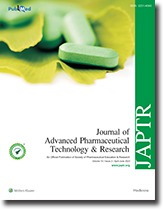
Nanomolar activity of 4-hydrazinylphenyl benzenesulfonate against breast cancer Michigan Cancer Foundation-7 cell lines

- Jurnal Internasional Bereputasi
- Riska Prasetiawati, Syahrul Hidayat, Adel Zamri, Muchtaridi Muchtaridi
- Journal of Advanced Pharmaceutical Technology & Research Vol. 13 Oktober 2022 Halaman 322-328 P-ISSN: 0976-2094 DOI:10.4103/japtr.japtr_435_22
Abstrak
Abstract
Hydrazine is an alkaline reduction compound which is widely used in synthesis. Based
on the structure–activity analysis, to elicit antitumor activity, the presence of the
N-methyl group is an absolute requirement. The aim of the research is to synthesize
a new hydrazine derivate compound that has potency as a novel anti-breast cancer.
4-hydrazinylphenyl benzenesulfonate was synthesized employing reduction and
diazotization methods. Structure characterization was carried out using Fourier
transform infrared (FTIR), C13-nuclear magnetic resonance (NMR), H1-NMR, and High
Resolution Time-of-Flight Mass Spectrometry (HR-TOF-MS). The anti-cancer activity of
this compound against breast cancer Michigan Cancer Foundation-7 (MCF-7) cell line
was determined using a PrestoBlue viability assay. The new of hydrazine derivative,
4-hydrazinylphenyl benzenesulfonate, has been successfully synthesized. The reduction
and diazotization methods have been successfully used in the synthesis of new
compound of hydrazine derivatives. Structure characterization of 4-hydrazinylphenyl
benzenesulfonate was established using FTIR, C13-NMR, H1-NMR, and HR-TOF-MS.
The anti-cancer activity of this compound against breast cancer MCF-7 cell line was
determined using a PrestoBlue viability assay with IC50 0.00246 µg/mL or 9.32 nM. In
conclusion, 4-hydrazinylphenyl benzenesulfonate was successfully synthesized as a
new candidate for anti-breast cancer compound.
Key words: Anti-breast cancer, hydrazine derivate, synthesis
Lihat Dokumen
